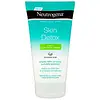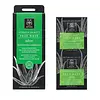What's inside
What's inside
 Key Ingredients
Key Ingredients

 Benefits
Benefits

 Concerns
Concerns

 Ingredients Side-by-side
Ingredients Side-by-side

Water
Skin ConditioningGlycerin
HumectantKaolin
AbrasiveBentonite
AbsorbentSodium Methyl Cocoyl Taurate
CleansingCI 77891
Cosmetic ColorantTrideceth-9
EmulsifyingPanthenol
Skin ConditioningSalicylic Acid
MaskingMenthyl Lactate
MaskingPEG-5 Ethylhexanoate
EmulsifyingSodium Chloride
MaskingXanthan Gum
EmulsifyingDisodium EDTA
Citric Acid
BufferingGlycolic Acid
BufferingSodium Citrate
BufferingSodium Hydroxide
BufferingParfum
MaskingCI 42053
Cosmetic ColorantWater
Skin ConditioningDodecane
PerfumingGlycerin
HumectantPropanediol Dicaprylate
EmollientSimmondsia Chinensis Seed Oil
EmollientTriticum Vulgare Germ Oil
EmollientButyrospermum Parkii Butter
Skin ConditioningPEG-40 Hydrogenated Castor Oil
EmulsifyingMel
EmollientAloe Barbadensis Leaf Juice Powder
Skin ConditioningSideritis Perfoliata Flower/Leaf/Stem Extract
AntioxidantSideritis Scardica Flower/Leaf/Stem Extract
AntioxidantSideritis Raeseri Flower/Leaf/Stem Extract
AntioxidantRosa Centifolia Flower Juice
Skin ConditioningPanthenol
Skin ConditioningSodium Hyaluronate
HumectantHelianthus Annuus Seed Oil
EmollientCitrus Aurantium Bergamia Peel Oil
Tocopherol
AntioxidantTocopheryl Acetate
AntioxidantAllantoin
Skin ConditioningSorbitan Oleate
EmulsifyingSodium Phytate
Carbomer
Emulsion StabilisingXanthan Gum
EmulsifyingGlyceryl Stearate
EmollientPEG-100 Stearate
Acrylates/C10-30 Alkyl Acrylate Crosspolymer
Emulsion StabilisingDehydroacetic Acid
PreservativeSodium Hydroxide
BufferingHydroxyacetophenone
AntioxidantCitronellyl Methylcrotonate
MaskingAlcohol
AntimicrobialParfum
MaskingBenzyl Alcohol
PerfumingCI 19140
Cosmetic ColorantCI 61570
Cosmetic ColorantWater, Dodecane, Glycerin, Propanediol Dicaprylate, Simmondsia Chinensis Seed Oil, Triticum Vulgare Germ Oil, Butyrospermum Parkii Butter, PEG-40 Hydrogenated Castor Oil, Mel, Aloe Barbadensis Leaf Juice Powder, Sideritis Perfoliata Flower/Leaf/Stem Extract, Sideritis Scardica Flower/Leaf/Stem Extract, Sideritis Raeseri Flower/Leaf/Stem Extract, Rosa Centifolia Flower Juice, Panthenol, Sodium Hyaluronate, Helianthus Annuus Seed Oil, Citrus Aurantium Bergamia Peel Oil, Tocopherol, Tocopheryl Acetate, Allantoin, Sorbitan Oleate, Sodium Phytate, Carbomer, Xanthan Gum, Glyceryl Stearate, PEG-100 Stearate, Acrylates/C10-30 Alkyl Acrylate Crosspolymer, Dehydroacetic Acid, Sodium Hydroxide, Hydroxyacetophenone, Citronellyl Methylcrotonate, Alcohol, Parfum, Benzyl Alcohol, CI 19140, CI 61570
Ingredients Explained
These ingredients are found in both products.
Ingredients higher up in an ingredient list are typically present in a larger amount.
Glycerin is already naturally found in your skin. It helps moisturize and protect your skin.
A study from 2016 found glycerin to be more effective as a humectant than AHAs and hyaluronic acid.
As a humectant, it helps the skin stay hydrated by pulling moisture to your skin. The low molecular weight of glycerin allows it to pull moisture into the deeper layers of your skin.
Hydrated skin improves your skin barrier; Your skin barrier helps protect against irritants and bacteria.
Glycerin has also been found to have antimicrobial and antiviral properties. Due to these properties, glycerin is often used in wound and burn treatments.
In cosmetics, glycerin is usually derived from plants such as soybean or palm. However, it can also be sourced from animals, such as tallow or animal fat.
This ingredient is organic, colorless, odorless, and non-toxic.
Glycerin is the name for this ingredient in American English. British English uses Glycerol/Glycerine.
Learn more about GlycerinPanthenol is a common ingredient that helps hydrate and soothe the skin. It is found naturally in our skin and hair.
There are two forms of panthenol: D and L.
D-panthenol is also known as dexpanthenol. Most cosmetics use dexpanthenol or a mixture of D and L-panthenol.
Panthenol is famous due to its ability to go deeper into the skin's layers. Using this ingredient has numerous pros (and no cons):
Like hyaluronic acid, panthenol is a humectant. Humectants are able to bind and hold large amounts of water to keep skin hydrated.
This ingredient works well for wound healing. It works by increasing tissue in the wound and helps close open wounds.
Once oxidized, panthenol converts to pantothenic acid. Panthothenic acid is found in all living cells.
This ingredient is also referred to as pro-vitamin B5.
Learn more about PanthenolParfum is a catch-all term for an ingredient or more that is used to give a scent to products.
Also called "fragrance", this ingredient can be a blend of hundreds of chemicals or plant oils. This means every product with "fragrance" or "parfum" in the ingredients list is a different mixture.
For instance, Habanolide is a proprietary trade name for a specific aroma chemical. When used as a fragrance ingredient in cosmetics, most aroma chemicals fall under the broad labeling category of “FRAGRANCE” or “PARFUM” according to EU and US regulations.
The term 'parfum' or 'fragrance' is not regulated in many countries. In many cases, it is up to the brand to define this term.
For instance, many brands choose to label themselves as "fragrance-free" because they are not using synthetic fragrances. However, their products may still contain ingredients such as essential oils that are considered a fragrance by INCI standards.
One example is Calendula flower extract. Calendula is an essential oil that still imparts a scent or 'fragrance'.
Depending on the blend, the ingredients in the mixture can cause allergies and sensitivities on the skin. Some ingredients that are known EU allergens include linalool and citronellol.
Parfum can also be used to mask or cover an unpleasant scent.
The bottom line is: not all fragrances/parfum/ingredients are created equally. If you are worried about fragrances, we recommend taking a closer look at an ingredient. And of course, we always recommend speaking with a professional.
Learn more about ParfumSodium Hydroxide is also known as lye or caustic soda. It is used to adjust the pH of products; many ingredients require a specific pH to be effective.
In small amounts, sodium hydroxide is considered safe to use. However, large amounts may cause chemical burns due to its high alkaline.
Your skin has a natural pH and acid mantle. This acid mantle helps prevent harmful bacteria from breaking through. The acid mantle also helps keep your skin hydrated.
"Alkaline" refers to a high pH level. A low pH level would be considered acidic.
Learn more about Sodium HydroxideWater. It's the most common cosmetic ingredient of all. You'll usually see it at the top of ingredient lists, meaning that it makes up the largest part of the product.
So why is it so popular? Water most often acts as a solvent - this means that it helps dissolve other ingredients into the formulation.
You'll also recognize water as that liquid we all need to stay alive. If you see this, drink a glass of water. Stay hydrated!
Learn more about WaterXanthan gum is used as a stabilizer and thickener within cosmetic products. It helps give products a sticky, thick feeling - preventing them from being too runny.
On the technical side of things, xanthan gum is a polysaccharide - a combination consisting of multiple sugar molecules bonded together.
Xanthan gum is a pretty common and great ingredient. It is a natural, non-toxic, non-irritating ingredient that is also commonly used in food products.
Learn more about Xanthan Gum